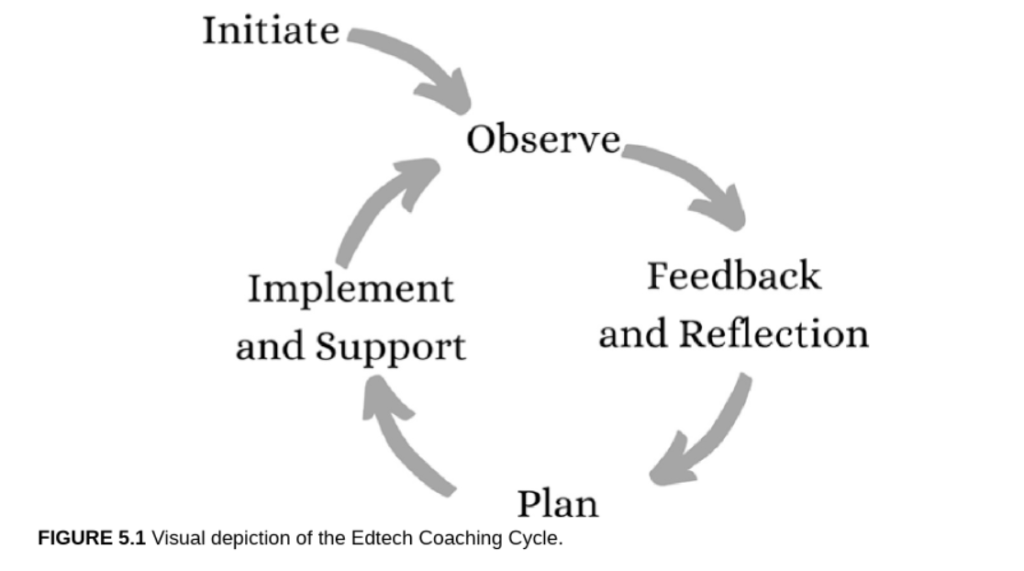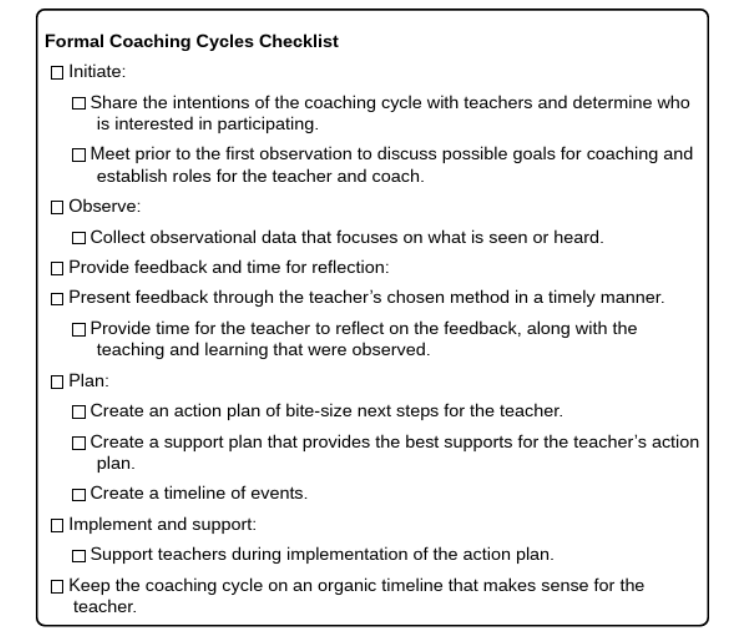
Establishing a shared agreement on how the meeting will go, whether it is in a coaching situation or not, may save time and energy to stay focused on the ‘actual’ goal of the meeting. Norms, which are collective agreements on how participants will work together, help address issues such as how participants treat each other, engage with challenging topics, and manage disagreements (Boudett, 2019). These general norms to specific norms are set to consider personalized needs and learning styles, enhancing participation and collaboration. Developing and understanding norms are crucial for a successful Edtech coaching cycle, and it is not just setting rules and boundaries but a collaborative effort to maintain them throughout the coaching cycle. A desired outcome of setting norms is creating a trustful, respectful environment that ensures transparent communication and aims to achieve learning goals for educators and students (McBride, 2021). ISTE STANDARDS FOR COACHES 1C. Cultivate a supportive coaching culture that encourages educators and leaders to achieve a shared vision and individual goals. “Coaching cycles can create a safe space for teachers to focus on growth goals (Kraft & Blazar, 2018).” So, how can we communicate and collaborate to set norms for a successful coaching cycle?

Identify Expectations
From behavioral expectations like being on time, turning off the phone during meetings, and not interrupting while someone is speaking, finding out the communication preferences of the educator, and suggesting a list of general norms to identify the expectations will help prepare for the first coaching session. Educators then have the option to choose from the list of norms they think are important to them and explain why or come up with their own to suggest to the coach. Also, a simple questionnaire to find out their communication styles, whether they like to communicate via email, in person, or Zoom conference, and if they prefer to have a printed copy of resources, they want a summary of each meeting, how much time does the educator need until the next meeting, etc… (McBride, 2021) will help the coach be able to simulate how the session will look and feel, removing the anxiety of not knowing what to expect.
Communication
Effective Edtech coaching begins with clear and open communication (Schembari, 2023). To establish a culture of honest and transparent communication, we need to create an environment where educators feel comfortable and safe to express their concerns, share their ideas, and ask questions without worries. Clear communication is vital for building trust because it ensures everyone is on the same page, eliminating misunderstandings and promoting unity with a shared goal. Additional communication norms to consider are:
- Show Respect: Recognizing that every educator is different. They will have personalized needs and have different levels of experience and expertise at different stages in their learning journey. So, having respect for individuality is crucial. Must show coaches value and appreciate each other’s views and strengths (Retrieved from Indeed website).
- Probe ideas, do not criticize others (Meyer et al., 2011): Edtech coaches need to provide feedback in a constructive and non-judgmental manner, explaining the reasoning behind a particular feedback. Setting this norm involves clearly stating that the purpose of feedback is to help educators improve, not to critique or criticize. By focusing on improvement and growth, trust is nurtured in the coaching relationship (McBride, 2021). Feedback is important because it serves as a tool for continuous improvement, and non-judgmental feedback ensures that educators are open to it, as they know it comes from a place of support and growth.
- Show Empathy and Understanding: Set the norm of empathy and understanding by actively listening to educators and offering support and resources that cater to their needs. Acknowledge the learning curve and demonstrate your commitment to helping them navigate it effectively. Empathy and understanding are essential because they create a safe space for teachers to be vulnerable about their struggles and aspirations (McBride, 2021).
Collaborative Decision-making
Collaboration is essential in the goal-setting and decision-making process. The collaborative norms consider educators’ individual needs and preferences to meet their unique learning styles. It is about something other than right or wrong but finding out what has been successful from previous experiences to put forward collaborative efforts to adopt best practices.
- Goal Setting: Effective collaboration is central to the success of Edtech coaching cycles. It establishes a process where coaches and educators collaboratively set goals, identifying where they want to go and how technology can enhance their teaching practices. This shared vision strengthens the coaching partnership, as teachers feel empowered and invested in their professional development (McBride, 2021). Collaborative goal setting is important because it ensures that the coaching process aligns with educators’ needs and objectives, making it more effective and meaningful.
- Problem-Solving: As accountable partners, it should be clear that problem-solving is a shared responsibility where both parties contribute to overcoming obstacles, creating a culture of collaboration, and reinforcing trust and teamwork. Collaborative problem-solving is crucial because it promotes a sense of ownership and responsibility, creating a unified front in addressing issues (Boudett, 2019).
Dealing with conflict
There will be times for disagreement; sometimes, coaches must give honest feedback. Sharing hard truths with educators can be challenging. Clear, honest, and respectful communication can help navigate these tensions while maintaining rapport with educators. Conflict resolution strategies include starting with curiosity, being clear and concise, framing feedback as observations rather than judgments, and promoting give-and-take conversations (Schembari, 2023). Being professional by backing reasoning with research and evidence to establish credibility in handling pushback and addressing educators’ responses to hard truths is crucial. Also, reminding teachers of shared goals and recognizing and encouraging their efforts could help them stay on track.
Feedback and Reflection
Edtech coaching is not a one-and-done process; it is an ongoing cycle of growth. Set the norm of regular feedback sessions, emphasizing their importance for evaluating progress, discussing achievements, and identifying areas for improvement. Observations are not to judge or evaluate but to look for need or improvement that aligns with educators’ goal and come up with ideas. Assuming positive intentions and having a feedback loop strengthens the coach-educator relationship by fostering a continuous learning and improvement culture. Regular feedback is crucial because it ensures that both parties stay on track, adapt to changing circumstances, and continue to grow together (Boudett, 2019).

In conclusion, setting and adhering to these norms, as emphasized in Ashley McBride’s “The Edtech Coaching Primer,” is essential for building trust and fostering collaboration in Edtech coaching. These norms enhance the effectiveness of Edtech coaching and lead to professional growth and learning improvement for students. Clear communication, respect for individuality, non-judgmental feedback, empathy, and understanding lay the foundation for trust (Schembari, 2023). Collaborative goal-setting, problem-solving, feedback loops, and professional development promote a culture of collaboration. When these norms are embraced, the Edtech coaching relationship becomes a powerful force for positive change in education, benefiting both educators and students. Coaches should provide opportunities for professional development that cater to the specific needs of educators. Setting norms for a coaching cycle involves actively seeking out and offering resources, workshops, and training that align with educators’ growth areas. Collaborating to set and understand norms and how they will play out in the actual coaching sessions, coaches demonstrate their commitment to the growth and development of educators, again fostering trust and collaboration (McBride, 2021). As stated in ISTE-C Standard 2: Connected Learner: c. Establish shared goals with educators, reflect on successes, and continually improve coaching and teaching practice. ISTE-C Standard 3: Collaborator: a. Establish trusting and respectful coaching relationships that encourage educators to explore new instructional strategies.
Reference
Boudett, K., & Lockwood, M. (2019, July 1). The power of team norms. ASCD. https://www.ascd.org/el/articles/the-power-of-team-norms
Indeed (2022, June 24). Meeting Norms: What They Are and How To Implement Them. https://www.indeed.com/career-advice/career-development/meeting-norms
Kraft, M., & Blazar, D. (2018). “Taking teacher coaching to scale: Can personalized training become standard practice?” Education Next, 18(4). https://link.gale.com/apps/doc/A556890659/OVIC? u=lom_accessmich&sid=OVIC&xid=2fa3e60e
McBride, Ashley. The Edtech Coaching Primer: Supporting Teachers in the Digital Age Classroom, International Society for Technology in Education, 2021. ProQuest Ebook Central, http://ebookcentral.proquest.com/lib/spu/detail.action?docID=6683479.
Meyer, K et al. (2011). Norms for Peer Coaching V4 – Slide
OpenAI. (2023). ChatGPT (September 25 Version) [Large language model]. https://chat.openai.com
Schembari, J. (2023, October 4). Navigating Challenging Communication as an Instructional Coach. EDUTOPIA. https://www.edutopia.org/article/challlenging-conversations-instructional-coaching


